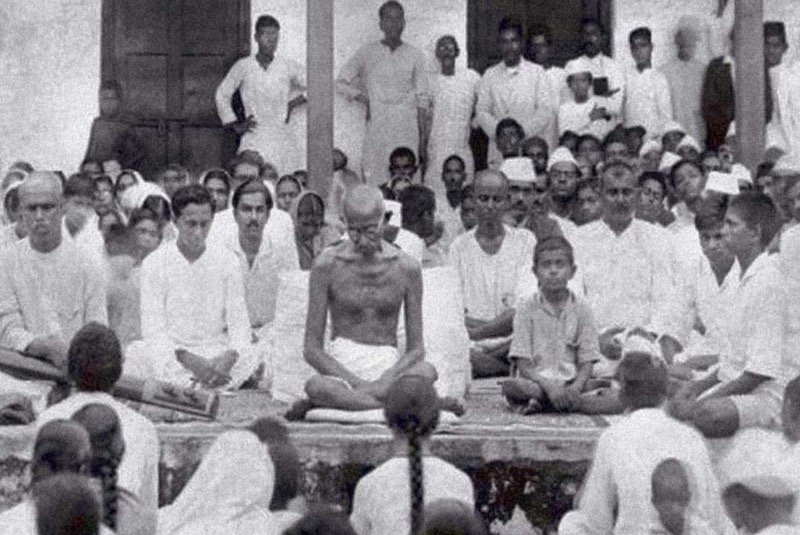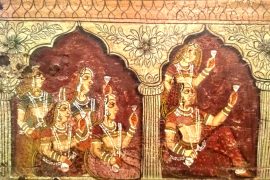In our Ashram there are no walls. The only walls we have are those of Ashram disciplines. But unlike the prison walls, they do not imprison, but protect us and release us into greater freedom…. Imprisoned, we shall miss no delights of the palate or any other physical indulgence, having accustomed ourselves to plain fare and the simple life… And since in prison a civil résister voluntarily observes the prison discipline and welcomes the hardships incidental to jail life as a part of suffering for truth, we shall feel happy and free like a bird even behind prison walls, we shall never weary. When the whole of India has learnt this lesson, India shall be free. For, if the alien power then turns the whole country into a prison, it will not be able to imprison its soul.
Along the banks of river Sabarmati, in suburban Ahmedabad, lies an Ashram, where the Satyagraha movement began. Even in blistering summers, the Aashram, Gandhi’s home for thirteen years–from 1017 to 1930–attracts people from all over the world.
Gandhi believed communal living could change the world. Through community living, Gandhi wanted to change the perception of need. At the Sabarmati Ashram, Gandhi showed that true freedom could only be achieved by living a simple life in a self-sufficient community. When less is more, nothing can be taken away to cause discomfort.
When Gandhi returned to India in 1914, he received overwhelming love. He met Gopal Krishna Gokhale in Poona and told him that he wanted to establish an Ashram to settle down. Gokhale promised to help him with the Ashram in any way he could; however, Gokhale died.
Gandhi, who had successfully led the experiments of Satyagraha in South Africa, promised Gokhale that he would travel across India before starting Satyagraha in India. Accordingly, Gandhi travelled far and wide across India to places like Rangoon and Haridwar. He attended the Kumbh Mela, where 1700 people gathered. At the Mela, Gandhi saw terrible sights of cheating, corruption, and poor sanitation. When he returned to Ahmedabad in 1915, he established his Ashram at a village nearby and focused on individual character development.
Gandhi had built two communities before this. In Phoenix, near Durban, he founded the colony of Natal in December 1904. From there, he led his first Satyagraha campaign in 1906. Gandhi also established a community on Tolstoy Farm, near Johannesburg, in the Transvaal Colony, from June 1910 until January 1913. He returned to the Phoenix and remained there until his departure to India.
Gandhi chose a site in Ahmedabad because he recognised the potential of reviving the cottage industry in a business-oriented city. Ahmedabad was also a city of wealth, making it easier to receive financial help to maintain the Ashram. In his autobiography, Gandhi had noted the following:
I had a predilection for Ahmedabad. Being a Gujarati, I thought I should be able to render the greatest service to the country through the Gujarati language. And then, as Ahmedabad was an ancient center of handloom weaving, it was likely to be the most favorable field for the revival of the cottage industry of hand-spinning. There was also the hope that since the city was the capital of Gujarat, monetary help from its citizens would be more available here than elsewhere.
The Ashram was based on simple rules: ‘Our creed is devotion to truth, and our business is the search for and insistence on truth,’ he said. Accordingly, everyone in the Ashram wore simple uniforms and had simple meals together in a common kitchen. Gandhi believed it’s ‘essential to observe the vows of truth, ahimsa, celibacy, non-stealing, non-possession, and control of the palate’ to serve people. Ergo, at the Ashram, Gandhi’s school focused on skills that aided self-sufficiency.
The community was not to discriminate between people; when Gandhi received an application from a family considered ‘untouchable,’ many objections were raised. Even his wife, Kasturba, had resisted their admittance. Once Kasturba refused to clean their urine pot, Gandhi went so far as to threaten her eviction from the Ashram.
Gandhi’s commitment to Ahimsa won the hearts of many influential people from the Hindu and Jain communities, who provided as ready financial support to the Ashram. However, when Gandhi used the principles of Hinduism to attack the social evil of untouchability, many patrons refused monetary help, and the Ashram faced a financial crisis. Fortunately, he received timely assistance from Ambalal Sarabhai, a Jain industrialist, and Gandhi upheld his Harijan cause, not only living and eating with them but also educating them at the Ashram.
In 1917, the Ashram was shifted to a piece of land by the banks of river Sabarmati. This was because the community needed to be self-sufficient. He wanted a barren land where they could experiment with cow breeding, animal husbandry, khadi weaving, etc.
The Ashram was donated by Dadhich Rishi. At the time, the Ashram was a wasteland full of snakes; however, Gandhi had ordered them not to be killed. When Gandhi visited the site for the first time, he said:
This is the right place for our activities to carry on the search for Truth and develop Fearlessness- for on one side are the iron bolts of the foreigners, and on the other, thunderbolts of Mother Nature.
The Ashram was located between the jail and the crematorium. However, that did not bother Gandhi. He connected it to the cause of Satyagraha and said that a Satyagrahi is bound to go to either place, which makes the location perfect for the Satyagraha Ashram.
The Ashram became the symbol of an ideal community that upheld the principles of non-violence and truth; it was a place which believed the followers could bring freedom to the motherland from the tyranny of the colonisers. On 12 March 1930, Gandhi launched the Dandi March from the Ashram, protesting against the British Salt law, which taxed Indians for the salt produced on Indian soil.
As he organised the protest from the Ashram, the British confiscated the place, and Gandhi was forced to disband the place on 22 July 1933. The Ashram became a place where many freedom fighters were detained; given its role in the Satyagraha movement, it was preserved by the locals.
Gandhi vowed to return to the Ashram only after India won Independence, which was not until 15 August 1947. However, Gandhi could not return as he was assassinated in January 1948.
The Satyagraha Ashram was monumental in the development of the theory of self-reliance, which became central to the idea of Swaraj. Today, the Ashram stands as a preserved memory of Gandhi’s mission and his principles. It receives more than 4000 visitors a day; Hridaykunj, the living quarters of Gandhi and his wife, is the main attraction. The site has also preserved the guestroom – Vinoba-Mira Kutir, prayer room, and Udyog Mandir (where Khadi was developed).
The quarters of Maganlal Gandhi, his nephew, who managed the Ashram at one time, have been turned into a Charkha gallery, and a library, a museum, and an exhibition area were added. As Sabarmati watches over the Ashram, the site hopes to preserve the spirit of Gandhi’s strong ideals of freedom: non-violence, truth, and self-reliance.
-30-
Copyright©Madras Courier, All Rights Reserved. You may share using our article tools. Please don't cut articles from madrascourier.com and redistribute by email, post to the web, mobile phone or social media.Please send in your feed back and comments to editor@madrascourier.com











